
Flavoromics is a omics technology to analyze the basis of flavor substances. It is an important part of systematic flavor research. It originates from metabolomics but different from metabolomics. Metabolomics mainly uses targeted and untargeted methods to identify all small molecule metabolites, while flavoromics is more inclined to identify flavor related metabolic components. Therefore, flavoromics is a targeted and comprehensive analysis of all flavor related metabolites on the basis of metabolomics.
PANOMIX identifies flavor substances based on chromatography-mass spectrometry. The chromatographic part adopts comprehensive two-dimensional gas chromatography (GC × GC) platform, is a new chromatographic analysis technology developed on the basis of traditional one-dimensional gas chromatography. The main principle is that two chromatographic columns with different separation mechanisms and independent of each other are connected in series, and a modulator is installed in the middle. All distillates separated by the first column are concentrated and aggregated in the modulator, and then released into the second column in the form of periodic pulses to continue separation, and finally enter the chromatographic detector. Through the separation method of chromatographic columns in series, the components (co-distillates) that are not completely separated in one dimension are further separated in two dimensions, which achieves the effect of orthogonal separation and greatly expands the separation capacity of chromatography.
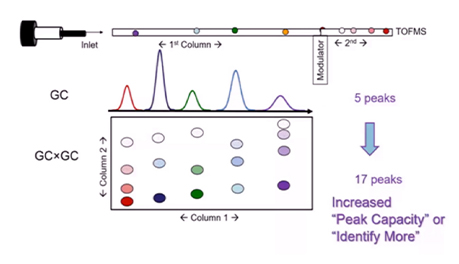
High resolution and high sensitivity GC × GC-TOFMS full two-dimensional gas chromatography detection platform combined with high acquisition rate (500 full spectra / s) time-of-flight mass spectrometry technology,integrating all the advantages of gas phase and high acquisition time-of-flight mass spectrometry. Its qualitative and quantitative capabilities surpass similar flight mass spectrometry, provides a perfect solution for the analysis of complex samples and unknown samples.
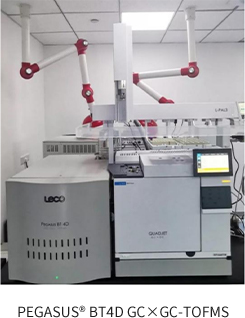
The GC×GC-TOFMS was comprehensively compared with other commonly used technologies in the market, including electronic nose, GC-MS, GC-IMS, and GC-TOFMS. The results are shown in the following table: Comparison Results of Commonly Used Techniques for Flavor Substance Identification

PANOMIX exclusively introduces a set of global fully integrated GC × GC-TOFMS system has opened a new chapter in the identification of flavor substances.
1. GC × GC-TOFMS has strong quantitative and qualitative capabilities
1)Quantitative ability High sensitivity, wide dynamic range and deconvolution provide lower detection limit and more accurate results × GC can greatly improve the chromatographic resolution and separate the target substance from the interference of background matrix. As shown in the figure below, one-dimensional GC and full two-dimensional GC of chloromethoxybenzene × Compared with GC quantitative standard curve, it can be seen that: GC × The high resolution of GC greatly improves the sensitivity and quantitative accuracy of quantitative chloromethoxybenzene, and the linear relationship is better.

2)Qualitative ability High resolution GC × GC greatly improves the number of qualitative peaks of the sample. For substances that are difficult to detect and qualitative in GC-MS, GC × The high resolution of GC-MS greatly improves the number of qualitative peaks of the sample.
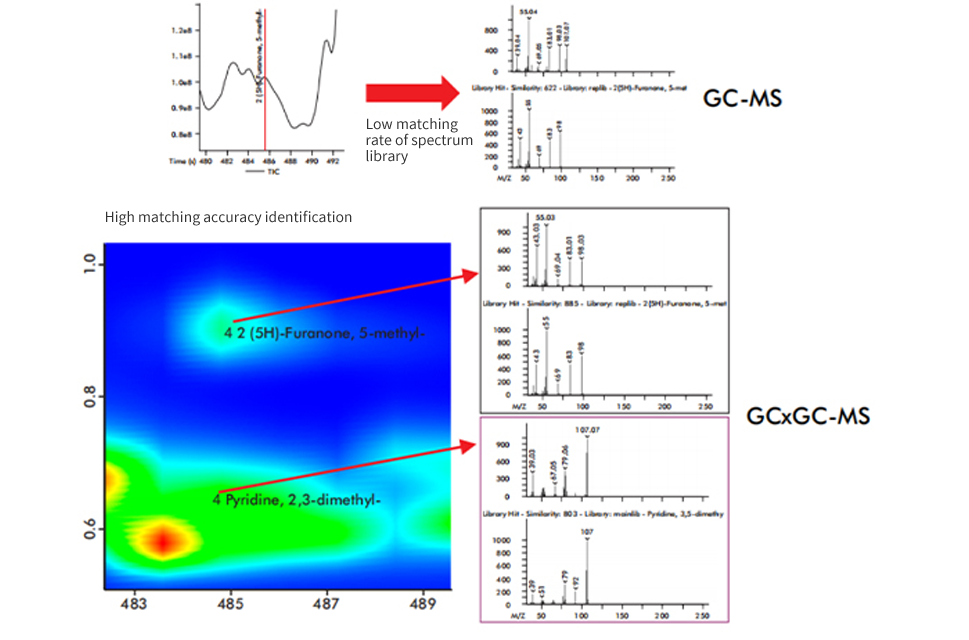
2. The full two-dimensional orthogonal separation mechanism greatly improves the peak capacity, chromatographic resolution and sensitivity
GC × GC adds thermal modulator to improve chromatographic peak capacity and resolution. One injection is equivalent to hundreds of central cutting and separation, and the sensitivity is much higher than that of central cutting and separation, and the sensitivity is greatly improved.

3. Can be combined with solid-phase
Solid phase microextraction (SPME) combined with GC-MS is the earliest and most mature technology. Applicable to GAs, volatile / semi volatile substances. GC × GC-TOFMS can be combined with solid phase microextraction.
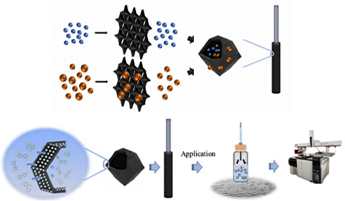
4.Compared with one-dimensional gas chromatography, the number of substances identified is greatly increased
1)The separation capacity of a single chromatographic column of one-dimensional gas chromatography can not meet the experimental analysis requirements of more than 150 ~ 250 component samples. If the separation degree is double, the column length needs to be increased by four times, but increasing the column length will reduce the separation speed and prolong the analysis time, GC × The two GC columns in series can effectively make up for the defects of poor GC separation effect, insufficient peak capacity and serious common flow interference.
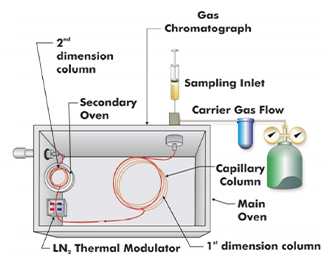
2)TOFMS has a high acquisition frequency, which greatly enhances GC × Qualitative capability of GC. In theory, TOFMS has no limit on the mass range of the measured object, and has extremely fast response speed and high sensitivity.
3)GC × GC-TOFMS realizes the best cooperation between two-dimensional chromatography system and high-throughput mass spectrometry × GC has tens to hundreds of times higher sensitivity than GC. By selecting different column systems, the separation and classification of different polar compounds can be realized, and the accuracy of chromatographic peak resolution can be greatly enhanced; GC × The chromatographic peaks separated by GC are purer and the background interference is greatly reduced. The powerful chroma TOF software can automatically resolve more than 100000 peaks at a time, and the reliability of mass spectrometry peak resolution is greatly improved; GC × GC-TOFMS can be used for both one-dimensional analysis and two-dimensional analysis, and its performance is much better than GC-MS. The following table compares the quantity of GC×GC and GC detected in some published literatures
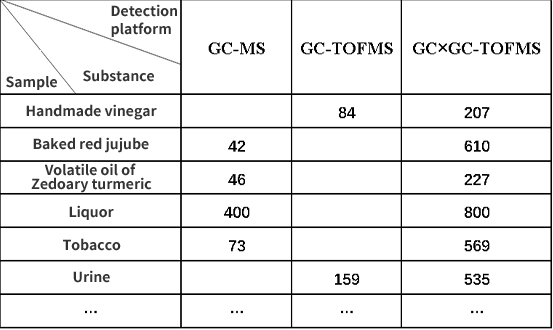
 2D-TIC
2D-TIC 3D-TIC
3D-TIC OPLS-DA score plot
OPLS-DA score plot Differential metabolite heat map
Differential metabolite heat map Flavoromics sankey diagram
Flavoromics sankey diagram Radar charts
Radar charts Associative network diagram
Associative network diagramJournal: Food Chemistry Impact factor: 6.306 Published date: 2020 Published by: South China University of Technology
Chinese Baijiu has attracted many kinds of attractive smell and taste, and has become one of the world famous distilled spirits. Baijiu contains a large number of volatile compounds, including alcohols, esters, fatty acids, furans, ketones, nitrogen-containing compounds and sulfur-containing compounds. According to their aroma characteristics, Chinese Baijiu can be classified into four basic aroma types, namely, light, soy sauce, rice and strong aroma-types of baijiu. Among these, the strong aroma-type baijiu (SAB), which is characterized by a fragrant flavor, soft mouthfeel, and long aftertaste, accounts for about 70% of the total amount of baijiu production. Ethyl hexanoate is the dominant ester exhibiting a fruity note, ethyl butanoate, ethyl pentanoate, ethyl octanoate, and 3-methylbutyl hexanoate are also important aroma contributors. SAB is primarily produced in two regions, namely, the Sichuan basin (SCB) and the Yangtze-Huaihe River Basin. The Baijiu production process from different origins is also different. To date, many studies have been carried out on the classification of alcoholic beverages, such as wine, rum and Chinese baijiu, according to their geographical origins. However, to the best of our knowledge, there are few studies on the classification of the strong aroma-type baijiu (SAB) according to their geographical origin.
In this study, a metabolomic approach was used as a bridge to connect the geographical origin to the volatile composition of the SAB samples based on liquid extraction (LLE) combined with GC×GC-TOFMS. Firstly, the raw data were processed by applying PCA and PLS-DA for untargeted analysis to identify potential markers. Afterwards, the marker compounds were identified and quantitated and then subjected to hierarchical cluster analysis (HCA) to verify the results of the untargeted analysis.
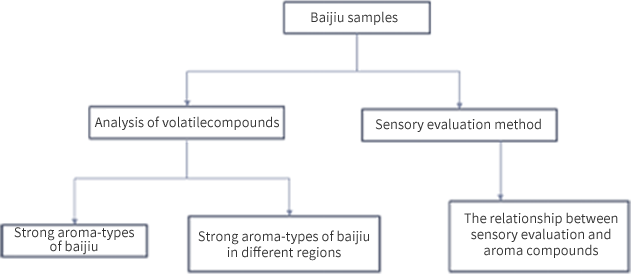
GC×GC-TOFMS was used to analyze 528 volatile compounds in Maotai liquor. PCA effectively separated the samples from these two regions. The PLS-DA training model was excellent, with explained variation and predictive capability values of 0.988 and 0.982, respectively. As a result, the model demonstrated its ability to perfectly differentiate all the unknown SAB samples. Twenty-nine potential markers were located by variable importance in projection values, and twenty-four of them were identified and quantitated. Discrimination ability is closely correlated to the characteristic flavor compounds, such as acid, esters, furans, alcohols, sulfides and pyrazine. Most of the marker compounds were less abundant in the SCB samples than in the YHRB samples. The quantitated markers were further processed using hierarchical cluster analysis for targeted analysis, indicating that the markers had great discrimination power to differentiate the SAB samples.
 PCA score plots for all samples
PCA score plots for all samples Markers identified in the gas chromatography profile of LZ-1
Markers identified in the gas chromatography profile of LZ-1 22 quantitative labeled compounds and randomly selected liquor samples were analyzed by heat map
22 quantitative labeled compounds and randomly selected liquor samples were analyzed by heat mapThe aroma characteristics of SAB in different regions were analyzed from chemical and sensory characteristics by GC×GC-TOFMS and sensory descriptive analysis. A variety of potential aromatic compounds (262 species) were identified, of which 58 compounds were significantly different in Sichuan basin (SCB) and the Yangtze-Huaihe River Basin. The relationship between these potential aroma compounds and sensory properties was studied by partial least squares regression and network analysis. We identified compounds that play a leading role in important sensory properties . The higher content of pyrazine, furan and carbonyl compounds in Sichuan is the main reason for the higher intensity of cellar aroma, baking aroma and grain aroma; The higher content of esters and alcohol in the samples from Yangtze-Huaihe River Basin is the main reason for the aroma of fruits and flowers. This method may have practical application in the flavor characterization of other alcoholic beverages.
[1] Xsa B , Si J B , Lin Z B , et al. Untargeted and targeted metabolomics strategy for the classification of strong aroma-type baijiu (liquor) according to geographical origin using comprehensive two-dimensional gas chromatography-time-of-flight mass spectrometry[J].
 © Copyright 2015-2022 Suzhou PANOMIX Biomedical Tech Co.,Ltd
© Copyright 2015-2022 Suzhou PANOMIX Biomedical Tech Co.,Ltd